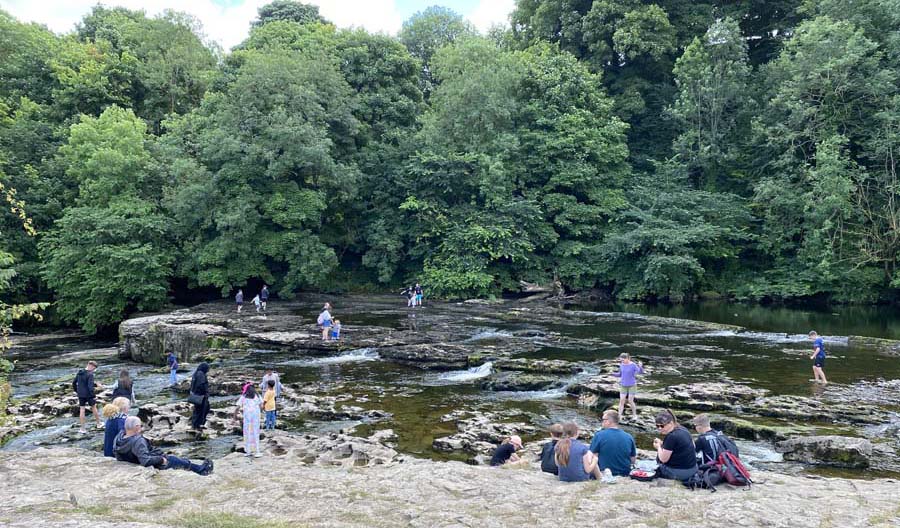
When teams of citizen scientists tested the waters of the River Ure in October it was found that the level of E.coli concentration at Aysgarth Falls was eight times higher than what is officially considered to be safe for bathing. Above: The Upper Falls at Aysgarth during August 2024
Prof Richard Loutoka, chairman of Stop Ure Pollution with which most of the volunteers were associated, commented: ‘It is a very disappointing result for the state of the river and worrying to think of all the people who use the river for various pastimes.’
In January 2025 SUP raised the alert when it was reported that raw sewage had been discharged into the Ure below Leyburn for 62 hours. Click on Three-Day Sewage Spill for the BBC story.
The water sampling on October 9th 2024, organised by Yorkshire Dales River Trust (YDRT) with the support of Stop Ure Pollution, involved ten teams of volunteers taking samples from 45 sites along the full length of the river and some of the tributaries. The samples were analysed by ALS Ltd for the faecal bacteria E.coli as well as nutrient and chemical analysis.
This was the second time a river-length water testing had been carried out. The first was in August when the water level was low and on that occasion there was a significant peak in E.coli levels from Bainbridge to Spennithorne.
The river was high on October 9th as there had been heavy rain during the day and night before. Event Duration Monitoring data from Yorkshire Water had shown that there had been some Combined Storm Overflows (CSOs) discharging prior to the testing including from Leyburn sewage works. This had discharged for 14 hours between7pm on October 8 to 9am on October 9.
On August 21st YDRT reported that 20 out of the 45 sites tested had E.coli concentrations above the levels ‘deemed sufficient for bathing water’ - 900 coliform forming units (cfu) per100 ml of water. On October 9 only four sites were recorded as having E.coli concentrations below that level and so could be considered to be safe for bathing.
YDRT reported that on October 9th ‘E.coli concentrations were high (over 2000 cfu/100ml) right from the top of the catchment at Lunds, peaking at Aysgarth footbridge (9800 cfu/100ml) and remaining high until West Tanfield. The E.coli concentrations then rose again at Bridge Hewick (3500 cfu/100m}, dropping slightly at Boroughbridge before rising dramatically at Aldborough (9500 cfu/100ml).’
It also reported that phosphates, ammonia and nitrite levels were consistently low along the length of the Ure until the lower end of the catchment. There were areas for concern at the Skell, Bishop Monkton, the Tutt and Aldborough.
It was found that, with the increase in water flow and turbulence, there was a general increase in suspended solids (fine particles of sediment) from Bainbridge to Burn Bridge, with small peaks in the Aysgarth area, Eshington Bridge and a larger peak on the Tutt. ‘Further analysis is needed to interpret the peaks at Aysgarth and further investigation is needed on the Tutt,’ the YDRT stated.
The next steps, it said, were : further analysis of the results and compilation of a full report using data from the sampling carried out in August and October, river levels, Event Duration Monitoring and other sources; and to work with the Environment Agency and others to increase understanding of E.coli levels in the Ure Catchment.
It also wants more E.coli testing on the stretch of river between Bainbridge and Jervaulx; plus further analysis on the Skell and Tutt tributaries as, it said, the results on the Tutt were of concern in more than one parameter.
